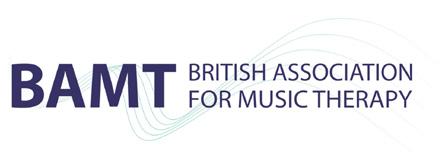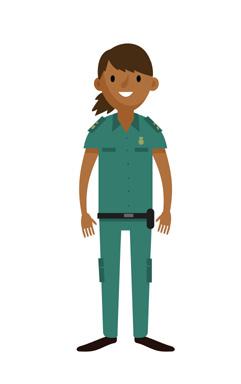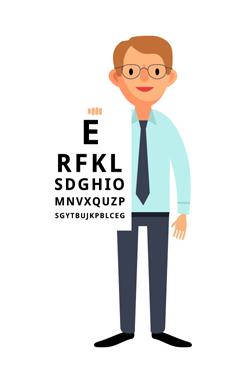Stakeholder advisory group
UK
Claire Aldridge
Chartered Society of Physiotherapy
Charlotte Beardmore Society of Radiographers
Helen Beaumont-Waters College of Paramedics
Jonathan Booth British Association for Music Therapy
Fiona Bush British and Irish Orthoptic Society
Paul Cooper Royal College of Occupational Therapists
Nicolette Divecha Allied Health Professions Federation
Spencer Goodman Society of Radiographers
Nikki Gratton
Deepti Loomba
Royal College of Speech and Language Therapists
Advanced Specialist Dietitian, Cleveland Clinic London
Fiona Main The College of Podiatry
Kathryn Moyse Royal College of Speech and Language Therapists
Debbie Oyewole British Association of Dramatherapists
Katie Prosser
Kathryn Robinson
British Association of Prosthetists and Orthotists
Head of Nutrition & Dietetics, Royal Wolverhampton NHS Trust
Matthew Rogers Institute of Osteopathy
International
Professor Cynthia Formosa University of Malta
Ritu Ghosh Mobility India
Kylie Shae World Health Organization
Associate Professor Cylie Williams Monash University, Australia
Dr MS Wong
The Hong Kong Polytechnic University; Hong Kong Society of Certified Prosthetist-Orthotists)
8
The COVID-19 pandemic has caused a rapid and sudden transition from face-to-face appointments to telehealth-mediated consultations in healthcare systems worldwide (2), including the UK NHS. This shift also affected AHP services, which had to quickly adapt to the restrictions imposed by the COVID-19 pandemic to ensure continuity of care. Although the use of telehealth was not new in the UK NHS services (3), the number of AHP services offering patient consultations via telehealth as part of their routine service program were in the minority in the pre-pandemic period (4), with telehealth being used to a greater or lesser extent across the various allied health professions. Therefore, the uptake and the large-scale implementation of telehealth as an alternative medium of delivering healthcare required a massive effort from AHP services, as AHPs are the third largest clinical workforce in the NHS, collectively delivering over four million patient contacts per week (5,6).
The digitalisation of healthcare continues to expand rapidly. The UK government has outlined its vision to embed digital technologies in routine healthcare use by 2025 and beyond (7), with the objective to provide better care and improved health outcomes for people. Similarly, the NHS is planning to offer digital first models of access to healthcare for most by 2029 (8), and the AHPs strategy (9) and the digital framework for AHPs (10) focusing on the utilisation of digital technology have recently been published. Telehealth is considered a valuable tool to improve access to healthcare services for people across the world, enabling equitable access to vulnerable and excluded populations (11).
Realising the full potential of telehealth demands comprehensive and multidimensional considerations (12). The increasing use of telehealth within AHP services is characterised by underlying challenges, such as the lack of adequate telehealth guidelines to support AHPs in the provision of remote consultations (13,14). The absence of comprehensive telehealth guidelines can pose barriers for healthcare professionals to provide care and can cause inequalities in access to healthcare services (14). Concerns about equity of access following the digitalisation of AHP services have been raised as telehealth may be considered incorrectly as a one-size-fits-all approach (16). On the contrary, digital strategies must embed personalised care approaches with shared decision making and the use of telehealth should be tailored to suit patients’ abilities, medical conditions, needs, preferences, values, and technological skills as well as resources (17). It is recommended that people are offered a hybrid blend of in-person and remote consultations, based on individual needs and preferences, the purpose of the consultation and the available resources (18).
However, current AHP telehealth guidelines do not fully capture the complex care needs of population groups for which telehealth-mediated interventions may be neither safe nor effective (14). Therefore, AHPs may offer telehealth to patients for whom it is not suitable or may not adopt compensatory measures during telehealth to make their remote consultations fully accessible, safe, and effective for everyone in the absence of an alternative method of service delivery. On the other hand, AHPs may not offer telehealth as a first option due to unconscious bias; where they may make assumptions about a person’s ability to utilise the technology based on a protected characteristic (e.g., age, disability or ethnicity). These issues may result in the provision of suboptimal care to people with complex needs, who may also be exposed to avoidable risks, or their unintended exclusion from telehealth consultations.
Additionally, many NHS AHP staff reported that they were not equipped with the skills necessary to deliver telehealth consultations (14). They reported to have received training mainly on telehealth technology-related aspects (e.g., software and hardware) and indicated that more training on implementation considerations, especially telehealth safety-related aspects, was required (14). Insufficient training can lead to inadequate patient safety and potential exposure of patients to avoidable risks during telehealth consultations. As the lack of comprehensive guidelines and training programmes can lead to unintended consequences, including the exacerbation of health inequities and inadvertent harm to patients (19), comprehensive telehealth guidelines and training programmes are essential to mitigate these risks in the face of the increasing adoption of telehealth.
This policy brief presents three key domains of telehealth (implementation, financial and, technical considerations) which we recommend be considered when designing telehealth guidelines. The considerations within each domain, although not intended to be exhaustive, provides a list of possible subdomains that may need to be addressed while designing telehealth guidelines. A list of considerations for staff training, to ensure AHPs have the necessary skills to provide telehealth consultations, is also provided.
We draw on evidence from a scoping review of telehealth guidelines and a survey of UK-registered AHPs and AHP service managers (13,14). Although the policy brief has been developed mainly based on data from UK AHPs, service managers and AHP professional bodies it: 1) considered patient users’ suitability, needs, and requirements; 2) has relevance in the global context; and 3) the framework can be adapted and applied in different contexts and healthcare systems to respond to individual circumstances.
9
Introduction
Recommendations
Framework of guiding principles for Allied Health Professional (AHP) telehealth consultations
Realising the full potential of telehealth demands comprehensive and multidimensional considerations. Telehealth implementation and financial and technical domains come together to influence the successful establishment and delivery of telehealth consultations. Our working group presents a guiding framework for telehealth guidelines with these three overarching domains, with each domain comprising multiple subdomains (see Table 1):
Implementation considerations include factors influencing clinical decision-making in remote consultations, organizational infrastructures, which comprise human elements (e.g., service users, their families, and telehealth healthcare teams), routines (e.g., documentation and checklist) as well as formal processes. 2 Financial considerations incorporate costs, reimbursement, and insurance coverage. 3
1
Technical considerations incorporate considerations of how technical infrastructures, including both telehealth material (e.g., physical and virtual space characteristics) and immaterial features (e.g., training), influence key issues such as privacy, risk, and safety when consulting remotely.
An infographic containing a summary of the framework for AHP telehealth guidelines is available in Figure 1.
Considerations for staff training for telehealth consultations.
A list of considerations, including both implementation (e.g., how to assess a patient’s suitability for telehealth, how to conduct a risk assessment prior to starting a telehealth consultation), and technical considerations (e.g., telehealth software and hardware). Staff training for telehealth consultations, is provided in Table 2. This list of training domains is not intended to be exhaustive, and we recommend that training is aligned with the needs of individual AHP.
12
Implementation considerations Descriptions
Purpose(s) telehealth can be used for
• Type of services telehealth can be used for (e.g., triage, advice provision, assessment, intervention, provision of a piece of equipment, patient education, service evaluation, staff supervision, staff support, collaboration within multidisciplinary teams and between organisations)
• ‘Red flags’ indicating a need for a face-to-face consultation
Patient’s characteristics to take into account to determine suitability of telehealth for individual/adopt measures to improve suitability, such as:
• Diagnosis
• Urgency of care
• Language skills and cultural background
• Speech and communication capacity
• Hearing and visual abilities
• Physical function
• Cognitive function
Share
• Mental health status
• Technological skills
• Availability of technology devices and access to the internet
• The geographical location of the patient
• Adequate home setting
• Willingness to participate in remote consultations
• Safeguarding issues
• Family’s and/or caregiver’s availability to provide support and facilitate consultations if needed
• Type of assessments and treatments (e.g., physical examination, hands-on interventions)
decision-making about telehealth use for consultations, which includes:
• Manage patient expectations about telehealth consultations
• Consideration of patient preferences and priorities
• Consideration of flexible hybrid consultation approach
• Inform patients about:
• Telehealth consultation purpose
• Telehealth possible benefits
• Telehealth risks (e.g.,
privacy, confidentiality and security)
• Telehealth limitations and barriers (e.g., limited assessment options, limited handson treatment, patientclinician communication, and relationship)
• Differences and similarities between telehealth and face-to-face consultations
• Other telehealth general characteristics
Risk management and patient safety
Patient records
(e.g., consultation length, consultation instructions, required level of commitment, privacy as well as confidentiality measures and costs)
• Possible alternative consultation options (e.g., face-to-face appointments)
• Possible compensatory measures/additional support needed to participate in telehealth
• Assessment of risks that may arise from the patient’s participation during the consultation (e.g., emotional distress, physical injuries)
• How to manage risks and unexpected events during the consultation (e.g., steps to follow in case of an emergency during the consultation)
• Emergency information (e.g., patient’s personal contact, alternative communication means, the physical location of the patient)
Obtain consent:
• Nature of consent (e.g., verbal, written or implicit consent by accepting to join the telehealth consultation)
• How to record consent
• How to document telehealth consultations (e.g., Subjective, Objective, Assessment/ Action, and Plan (SOAP) format)
• Type of information that needs to be documented (e.g., consent; subjective information, and clinical outcomes; safeguarding issues; equipment used during the consultation;
• People that participated in the virtual consultation; resources provided to the patient; additional information received from the patient (e.g., images, audio, or video recordings); limitations encountered during the consultation, such as assessment and treatment limitations; adverse events occurred during telehealth consultation, subsequent actions taken and following outcome and plan; technology limitations and safety limitations)
• Measures to keep patient records confidential
Table 1: A framework of guiding principles for Allied Health Professional (AHP) telehealth consultations with examples.
Suitability of telehealth solutions for each individual; and potential measures to improve suitability
13
Who is involved in telehealth consultations and their roles
Patient Healthcare professionals
• Professionals involved in the telehealth multidisciplinary team
• AHP students on placement
• Telehealth service coordinator and AHP team leader
• Support teams (e.g., triage team)
Evaluation strategies of telehealth use and effectiveness
Clinicians’ and patients’ checklist
• Administrative and IT teams offering logistic and technical support (e.g., booking system, technical failure management)
Family and caregivers
• Family’s and/or caregiver’s role in supporting telehealth consultations
• Continuous monitoring process (e.g., objective and patient-reported outcome measures, outcome measures about staff wellbeing, evaluation of impact across the local healthcare system)
• Use of quality improvement strategies (e.g., online questionnaire, patient’s and their family’s feedback, service improvement initiatives)
• Using up-to-date evidence-based knowledge while providing telehealth patient consultations
• Using up-to-date evidence about the use of telehealth with particular client groups
• Continuous monitoring of health inequalities
To follow before, during and after a telehealth consultation:
• Checklist with items clinicians should meet before, during and after a consultation (e.g., risk evaluation, how to set up the environment, instructions on how to proceed in case of technical failure, equipment needed for assessment/treatment, feedback on the telehealth session, information to record)
• Checklist with items patients should meet before, during and after a consultation (e.g., equipment needed, how to set up the environment, instructions on how to proceed in case of technical failure, cost details, feedback on the consultation)
Financial considerations Descriptions
Costs, reimbursement and coverage
Technical considerations
• Telehealth consultation costs
• Information about the reimbursement process within and across nations/states
• Insurance coverage for telehealth
• Information about insurance coverage within and across nations/states
• Cost of setting up and maintaining service (e.g., equipment, training, administration)
Descriptions
Patient’s telehealth training
• Information sheet explaining telehealth
• Telehealth trial
• Training to respond to technical disruption
Patients’ and AHPs’ telehealth training
AHPs’ telehealth training
• Family’s and/or caregiver’s role in supporting telehealth consultations
• Training to respond to technical disruption
• Training to manage adverse events
• Training to respond to an emergency during a telehealth consultation (e.g., patient cardiac arrest)
• Safeguarding training
• Continuing professional development training programmes
Session requirements
• Consultation length
• Characteristics of internet connection (e.g., bandwidth and speed)
Technical requirements
• Technical equipment needed for consultations (e.g., camera, headphones, external microphone, external sound cards)
The session, room and technical requirements
• Telehealth platforms allowed
• Measures to protect patient confidentiality during/after patient consultation
Room requirements
• Room characteristics (e.g., private and quiet room, good lighting, minimal distraction, adequate space to conduct a physical assessment/treatment)
• Other equipment needed to deliver the assessments and/or interventions (e.g., gym ball)
• Technical procedures to follow to ensure patient’s privacy and information security during data access, transmission and storage (e.g., password and authentication procedures)
Legislation, legal and ethical aspects
• AHPs’ licensure and registration requirements to practice within and across nations/states
• AHPs’ regulation and scope of practice
• Relevant local, national, institutional,
• and professional regulations and policies governing telehealth
• Laws regulating telehealth
• Telehealth code of ethics
• Information governance
14
Infographic
the
Implementation considerations Financial considerations Technical considerations CONSULTATION COSTS, REIMBURSEMENT PROCESSES, AND INSURANCE COVERAGE PURPOSE(S) TELEHEALTH CAN BE USED FOR PATIENT RECORDS INDIVIDUAL SUITABILITY AND POTENTIAL MEASURES TO IMPROVE SUITABILITY TELEHEALTH TRAINING FOR PATIENTS AND AHPS LEGISLATION, LEGAL AND ETHICAL ASPECTS CLINICIANS’ AND PATIENTS’ CHECKLIST RISK MANAGEMENT AND PATIENT SAFETY SESSION, ROOM AND TECHNICAL REQUIREMENTS EVALUATION STRATEGIES OF TELEHEALTH USE AND EFFECTIVENESS WHO IS INVOLVED AND THEIR ROLES 15
Figure 1:
summary of
framework for the development of AHP telehealth consultation guidelines.
Implementation considerations
How to assess a patient’s suitability for telehealth
How to promote shared decision-making and ensure personalised care
How to prepare patients for telehealth consultations
How to conduct a risk assessment prior to starting a telehealth consultation
How to conduct a clinical assessment via a telehealth consultation
How to provide a treatment intervention via a telehealth consultation
How to ensure patient confidentiality when conducting telehealth consultations
How to deal with distressing conversations during a telehealth consultation
How to deal with an emergency during a telehealth consultation
How to get feedback from patients and their families about telehealth consultations
How to use the software required for conducting telehealth consultations
Technical considerations
How to use the hardware required for conducting telehealth consultations
Conclusion
This policy brief, though not exhaustive, should serve as a basis for designing comprehensive guidelines and training for AHP telehealth consultations. A multidimensional telehealth framework for AHP consultations offers the opportunity to move toward a more integrated model of care, rather than merely focusing on tools and technologies. We propose that the use of this policy brief in the design of future telehealth guidelines and training and, consequently, in the delivery of AHP telehealth consultations may reduce digital exclusion and health inequities. It may also lead to reductions in the burden of treatment, telehealth barriers, and wider inequities between allied health professions and nations, thereby ultimately facilitating the successful implementation of healthcare digital transformation.
Table 2: Considerations for staff training for telehealth consultations.
16
References
1 WHO Global Observatory for eHealth. Telemedicine: opportunities and developments in Member States: report on the second global survey on eHealth. World Health Organization [Internet]. 2010 [cited 2022 Jul 21]. Available from: https://apps.who.int/iris/handle/10665/44497
2. Bhaskar S, Bradley S, Chattu VK, Adisesh A, Nurtazina A, Kyrykbayeva S, et al. Telemedicine Across the Globe-Position Paper From the COVID-19 Pandemic Health System Resilience PROGRAM (REPROGRAM) International Consortium (Part 1). Front Public Health. 2020 Oct 16;8.
3. Hutchings R. The impact of Covid-19 on the use of digital technology in the NHS [Internet]. 2020 [cited 2022 Oct 31]. Available from: https://www.nuffieldtrust.org.uk/files/2020-08/the-impact-of-covid-19-on-the-use-of-digital-technologyin-the-nhs-web-2.pdf
4. Eddison N, Healy A, Calvert S, Chockalingam N. The emergence of telehealth in orthotic services across the United Kingdom. Assistive Technology. 2021;
5. Dougall D, Buck D. My role in tackling health inequalities. A framework for allied health professionals. 2021;
6. NHS England. About AHPs [Internet]. [cited 2022 Oct 31]. Available from: https://www.england.nhs.uk/ahp/about/
7. Department of Health & Social Care. A plan for digital health and social care [Internet]. 2022 [cited 2022 Oct 13]. Available from: https://www.gov.uk/government/publications/a-plan-for-digital-health-and-social-care/a-plan-for-digital-healthand-social-care#section-1-embedding-digital-technologies
8. NHS. The NHS Long Term Plan [Internet]. 2019. Available from: https://www.longtermplan.nhs.uk/wp-content/ uploads/2019/08/nhs-long-term-plan-version-1.2.pdf
9. NHS England. The Allied Health Professions (AHPs) Strategy for England – AHPs Deliver [Internet]. 2022 [cited 2022 Jul 21]. Available from: https://www.england.nhs.uk/publication/the-allied-health-professions-ahps-strategy-for-england/
10. NHS England. A Digital Framework for Allied Health Professionals [Internet]. 2019 [cited 2022 Jul 21]. Available from: https://www.england.nhs.uk/publication/a-digital-framework-for-allied-health-professionals/
11. World Health Organization, & United Nations Children’s Fund (UNICEF). (2022). Global report on assistive Technology. https://apps.who.int/iris/handle/10665/354357
12. Greenhalgh T, Rosen R, Shaw SE, Byng R, Faulkner S, Finlay T, et al. Planning and Evaluating Remote Consultation Services: A New Conceptual Framework Incorporating Complexity and Practical Ethics. Front Digit Health. 2021 Aug 13;3.
13. Leone E, Eddison N, Healy A, Royse C, Chockalingam N. Exploration of implementation, financial and technical considerations within allied health professional (AHP) telehealth consultation guidance: a scoping review including UK AHP professional bodies’ guidance. BMJ Open. 2021;11(12):e055823.
14. Leone E, Eddison N, Healy A, Royse C, Chockalingam N. Do UK Allied Health Professionals (AHPs) have sufficient guidelines and training to provide telehealth patient consultations? Hum Resour Health. 2022;
15. Graham ID, Harrison MB. Evaluation and adaptation of clinical practice guidelines. Evid Based Nurs. 2005;8(3):68–72.
16. Alverson DC, Holtz B, D’Iorio J, Devany M, Simmons S, Poropatich RK. One size doesn’t fit all: Bringing telehealth services to special populations. Vol. 14, Telemedicine and e-Health. 2008. p. 957–63.
17. Greenhalgh T, Rosen R, Shaw SE, Byng R, Faulkner S, Finlay T, et al. Planning and Evaluating Remote Consultation Services: A New Conceptual Framework Incorporating Complexity and Practical Ethics. Front Digit Health. 2021 Aug 13;3.
18. The Chartered Society of Physiotherapy. National Evaluation of Remote Physiotherapy Services: Summary of the main findings [Internet]. 2022. Available from: https://www.csp.org.uk/system/files/documents/2022-02/001930_national_evaluation_ remote_services_a4_download_final2_003.pdf
19. Eddison N. Healy A. Leone E. Royse C and Chockalingam N. The potential impact of allied health professional telehealth consultations on health inequities and the burden of treatment. Int J Equity Health [Internet]. 2022;21(91). Available from: https://doi.org/10.1186/s12939-022-01689-2
20. NHS England and NHS Improvement. The 14 allied health professions. Available from: https://www.england.nhs.uk/ahp/role
21. NSW Agency for Clinical Innovation. Guidelines for the use of Telehealth for Clinical and Non Clinical Settings in NSW. 2015; Available from: https://www.telemedicine-360.com/wp-content/uploads/2019/02/2015-ACI-telehealth-guidelines.pdf
22. Slovensky DJ, Malvey DM, Neigel AR. A model for mHealth skills training for clinicians: meeting the future now. Mhealth. 2017 Jun 15;2:24–24.
23. National Audit Office. Digital Transformation in the NHS [Internet]. 2020 [cited 2022 Jul 21]. Available from: https://www.nao.org.uk/report/the-use-of-digital-technology-in-the-nhs/
24. Reddy V, Brumpton L. Digital-driven service improvement during the COVID-19 pandemic. Paediatr Child Health. 2021 May 1;31(5):220–2.
25. Health and Care Professions Council. Record keeping [Internet]. 2022. [cited 2022 Nov 29]. Available from: https://www.hcpc-uk.org/standards/meeting-our-standards/record-keeping/
26. European Commission. Rules for business and organisations [Internet]. 2022. [cited 2022 Nov 29]. Available from: https://ec.europa.eu/info/law/law-topic/data-protection/reform/rules-business-and-organisations_en
Staffordshire University College Road University Quarter Stoke-on-Trent Staffordshire ST4 2DE +44 (0)1782 294000
103163A




 January 2023 © Centre for Biomechanics and Rehabilitation Technologies, Staffordshire University, Leek Road, Stoke on Trent
January 2023 © Centre for Biomechanics and Rehabilitation Technologies, Staffordshire University, Leek Road, Stoke on Trent












 Association of Art Therapists
Association of Prosthetists and Orthotists
Association of Art Therapists
Association of Prosthetists and Orthotists

















